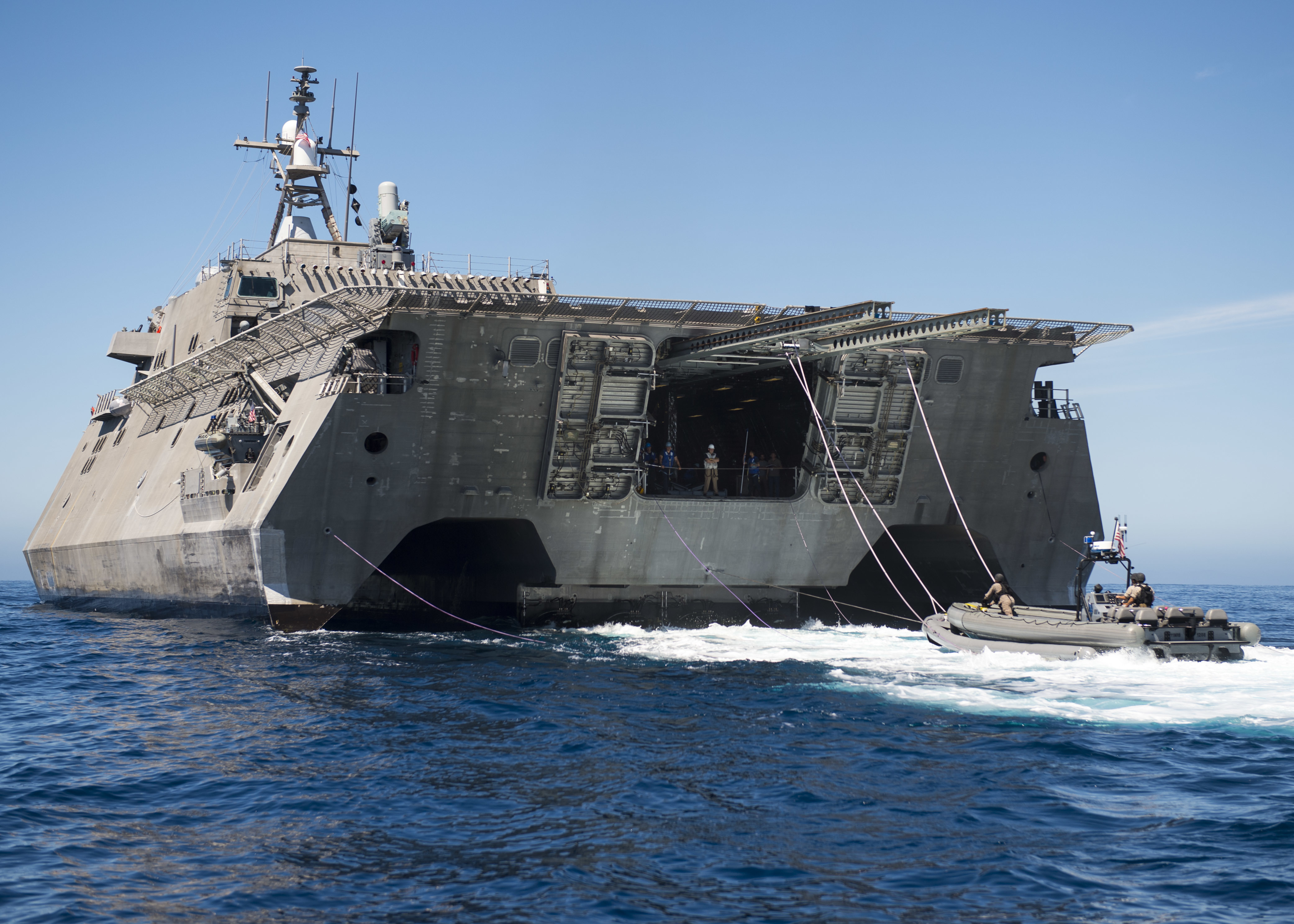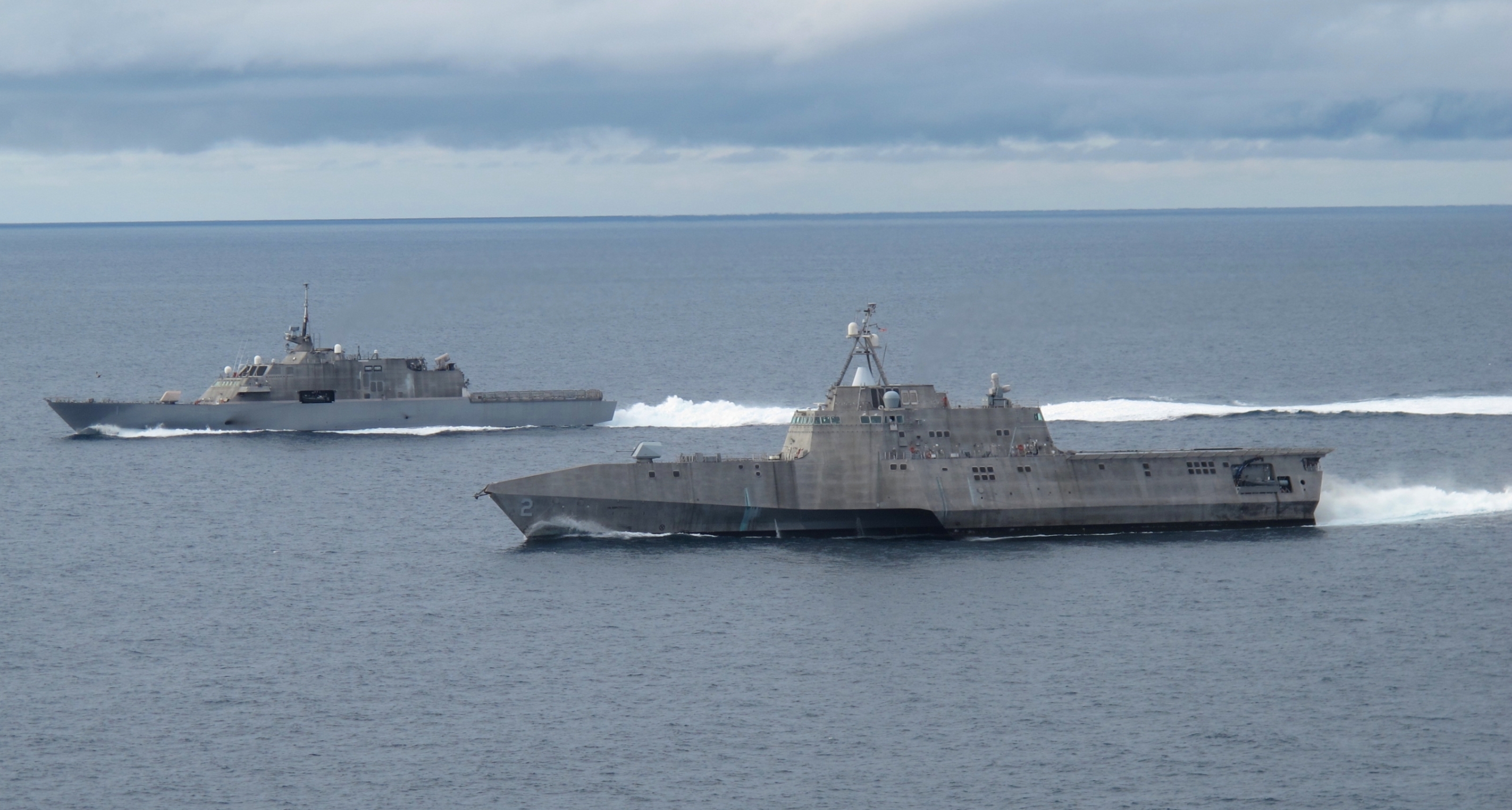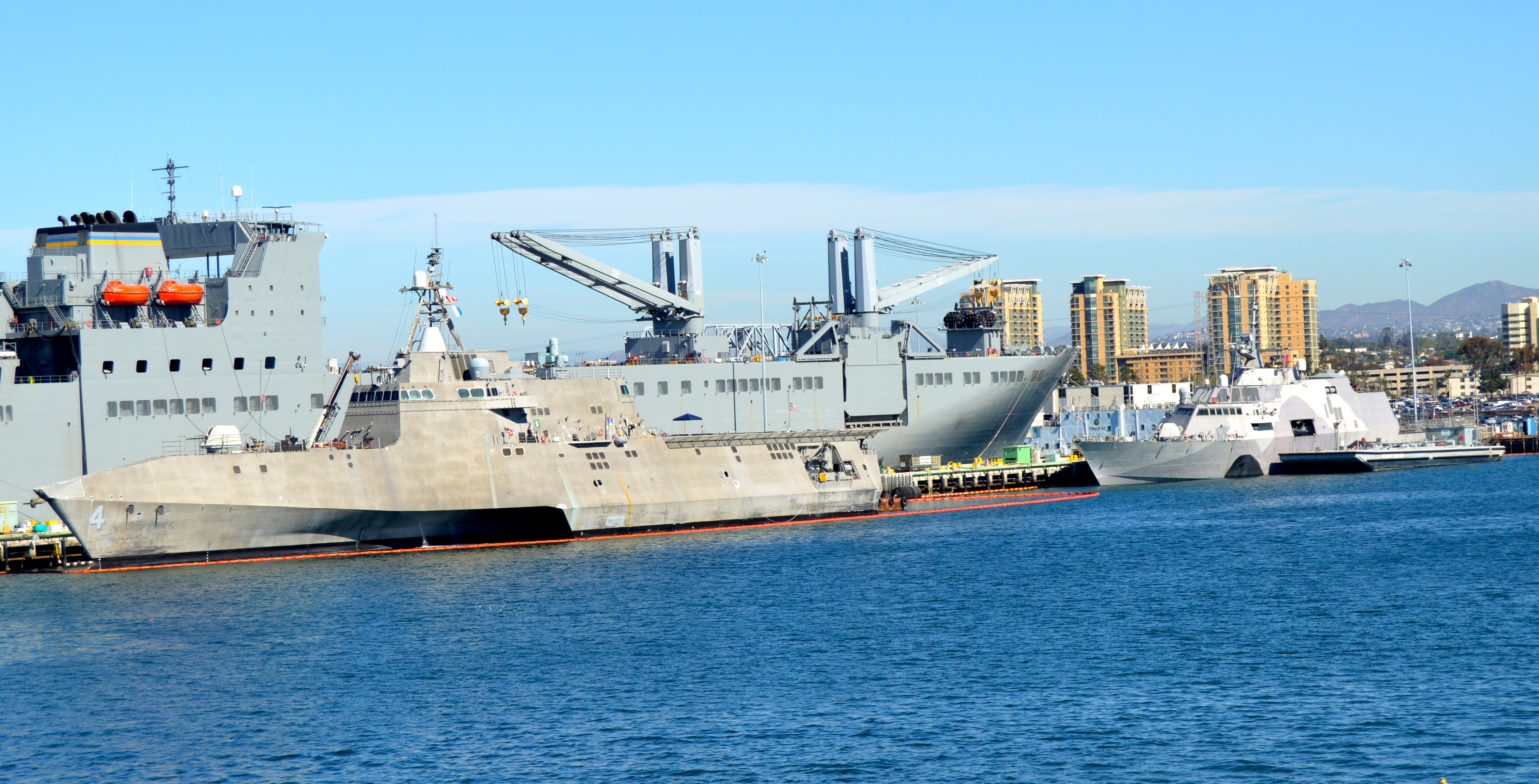
WASHINGTON NAVY YARD – As the Navy shifts from a two-variant frigate acquisition plan to a competition between the two Littoral Combat Ship builders, getting USS Coronado (LCS-4) out on its first deployment ahead of the frigate downselect will go a long way in validating the ship’s advertised capabilities, the Program Executive Officer for Littoral Combat Ships told USNI News.The first two Lockheed Martin Freedom-variant LCSs, USS Freedom (LCS-1) and USS Fort Worth (LCS-3), have both deployed for a total of about 28 months of forward-deployed experience. Coronado, though, will be the first Austal USA-built Independence-variant LCS to deploy overseas.
PEO LCS Rear Adm. Brian Antonio said in a May 2 interview that the actual performance of the two LCS variants will not be a factor as the Navy selects just one variant to move ahead in the frigate program. But the operational deployment will help the Navy validate claims the two shipbuilders make about their variants’ endurance, maintainability and other capabilities – and Coronado’s deployment will happen just in time to help inform the likely Fiscal Year 2018 downselect.
“It’s not just going to be a straight price shoot-out, it’s going to be: okay industry, here are the capabilities that are important to the Navy, to the fleet—what can you incorporate into your individual variant that would make the ship more capable?” Antonio said of the frigate competition.
“By getting a full deployment, or at least most of a deployment, under our belt, because we’ve already got the monohull deployment, at least then when the industry comes back and says we can meet this capability level and this capability level with the (Independence-variant) trimaran, we will have a better idea, a better sense if that’s in fact the case or not – endurance capability, carry extra weapons, that sort of thing in terms of the capability piece. … A downselect criteria isn’t going to be how well did the variant perform on deployment, but it is going to help us inform from a risk reduction perspective.”
New Acquisition Plan

The Navy was headed towards a two-builder frigate program, with the Navy and both shipbuilders collaborating to increase commonality in the combat systems, weapons and other mission-related features of the ships while retaining the two very different ship frames – the monohull Freedom variant and the aluminum trimaran Independence variant. Now, in what Antonio called a “fundamental shift” in the competitive environment, only one builder will participate in the frigate program – and Navy acquisition chief Sean Stackley has predicted that the losing bidder will likely be forced out of business if it can’t find sufficient commercial shipbuilding work.
In this new competitive environment, the two builders will need to find innovative improvements to add to their ship designs to distinguish themselves, rather than the former focus of meeting in the middle to increase commonality. Antonio said a draft request for proposals would come out this summer to help the builders understand what the Navy is looking for – and although he said he could not go into much detail, Antonio said the winner would be selected based on both cost and best capability. PEO LCS has engaged the fleet to understand what capabilities are most important and what improvements sailors want to see on the frigate, and the winning design will best meet the sailors’ requests at a reasonable cost.
When Secretary of Defense Ash Carter ordered the Navy to choose a single frigate contractor and curtail the program, he called for a downselect by FY 2019. Initially, several Navy leaders alluded to the fact that Carter would likely leave office before the downselect would take place and suggested that perhaps the Navy might wait him out and see what the next defense secretary decided about the future of the frigate program. Antonio, though, said there was a window of opportunity to get started on the frigate design and conduct a well-informed downselect, and the PEO decided to move quickly to take advantage of that opportunity.
“The issue is, if we had to downselect too early [in the design process] we would be basing it on an LCS design. This way we can work with the shipbuilders, get the necessary design work done to get to a set of specifications that they can bid on, and make the decision really on their frigate design as opposed to an LCS design,” Antonio said in the interview.
“We wanted to make sure we made the decision with the right level of knowledge in place and not base it on, okay, one of you all are going to get the very last LCS and it’s a shootout for who can make the best power point slides and tell us who’s got the best frigate.”
Carter’s plan would have the Navy award a single-LCS contract in 2018, which could drive the other yard out of business, meaning the winner of that LCS contract would end up being the frigate contractor as well. Antonio said that having a technical data package for a frigate competition in 2018, thereby turning the last LCS into the first frigate, would have multiple benefits, including clarity that the selection is based strictly on the frigate program rather than the last LCS playing a role. Additionally, though not a primary decision-driver, Antonio said converting the 2018 LCS into a frigate would have the benefit of resulting in 28 LCSs and 12 frigates – even numbers which better accommodate the current 3-2-1 manning concept in which three crews support two ship hulls, one of which is forward deployed.
Getting Real World Experience

With fleet input being so important in the frigate downselect process, introducing the Independence-variant to the fleet with Coronado’s deployment this summer will be important. Antonio said sailors worked Independence hard off the coast of Florida last year during mine countermeasures mission package testing, but with deployment to U.S. 7th Fleet, “that real-world experience is going to play heavy into the way the ship’s accepted.”
Antonio, who took over as PEO three years ago and will turn the office over to Rear Adm. John Neagley in a change of command ceremony next week, said he is very excited “see how [Coronado] interacts with the other foreign navies, see how she’s received by the other navies. Really kind of get her out there and put her through crew rotations, forward deployed – it’s going to be phenomenal.” He added that both variants have their own advantages, but one of Independence’s is a massive amount of internal volume, above and beyond the ship’s requirements, and “to see what the fleet can do with the volume that LCS-4 is going to present to them I think will also add to the acceptance across the fleet.”
Despite the differences between the two ship designs, Antonio said there is actually a lot that can be learned from the Freedom and Fort Worth deployments that will set Coronado up for success. The Navy used San Diego-based logistics for the Freedom deployment and switched to Commander of Logistics Group Western Pacific (COMLOGWESTPAC)/Commander Task Force 73 for the Fort Worth deployment. The PEO will look at which contracting model was more effective before deciding how to conduct logistics for the Coronado deployment. Similarly, Fort Worth had significantly fewer casualty reports (CASREPS) during the deployment than did Freedom, and the CASREPS it did experience were resolved faster. Antonio said that, though the Independence-variant ships use different components, the same predictive models and procedures that helped smooth out repairs for the Fort Worth deployment would be applied to the upcoming Coronado deployment.
“From a process perspective, we’re taking a look at, what did we not plan well enough and what can we do better in the planning to get ready,” he said. The command and control structure that outlines how decisions are made when something on the ship breaks, for instance, are still up for discussion ahead of Coronado deploying, though Antonio said Austal USA planned to set up an office in Singapore so as to be on site to assist as needed.
Finally, he said, Freedom will go out on her second deployment partway through Coronado’s first, creating the first-ever two-LCS forward deployed sustainment scenario for the Navy – “but that shouldn’t mean we need twice as many people, twice as many parts, twice as much the cost. It shouldn’t mean that. There is a scalability factor, some economic order of quantity efficiency,” he said, but the PEO is still working through plans for the LCS duo next year.





